
Portrait of Baldassare Castiglione is a c. 1514–1515 oil painting attributed to the Italian High Renaissance painter Raphael. Considered one of the great portraits of the Renaissance, it has an enduring influence. It depicts Raphael's friend, the diplomat and humanist Baldassare Castiglione, who is considered a quintessential example of the High Renaissance gentleman.

The Eleven Caesars was a series of eleven painted half-length portraits of Roman emperors made by Titian in 1536–1540 for Federico II, Duke of Mantua. They were among his best-known works, inspired by the Lives of the Caesars by Suetonius. Titian's paintings were originally housed in a new room inside the Palazzo Ducale di Mantova. Bernardino Campi added a twelfth portrait in 1562.
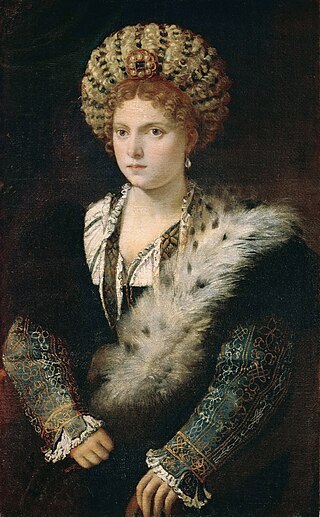
Portrait of Isabella d'Este is a an oil on canvas painting of a young woman by Titian. It can be dated to the 1530s and is held in the Kunsthistorisches Museum, in Vienna. The artist and the date are undisputed. Beyond the museum documentation, there are several doubts about the person depicted.
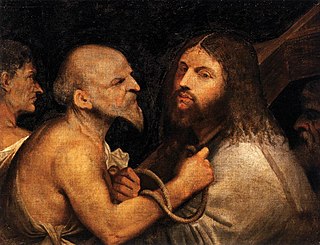
Christ Carrying the Cross is an oil painting attributed to either Titian or Giorgione. It is dated to about 1505. The painting is housed in the Scuola Grande di San Rocco in Venice, Italy. There are several later versions of the subject by Titian.
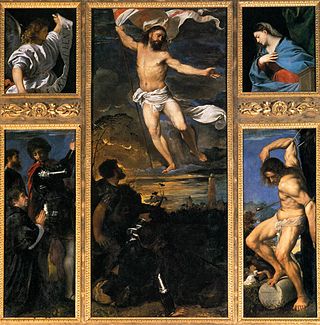
The Averoldi Polyptych, also known as the Averoldi Altarpiece, is a painting by the Italian Renaissance painter Titian, dating to 1520–1522, in the basilica church of Santi Nazaro e Celso in Brescia, northern Italy.

Lucretia and her Husband Lucius Tarquinius Collatinus or Tarquin and Lucretia is an oil painting attributed to Titian, dated to around 1515 and now in the Kunsthistorisches Museum in Vienna. The attribution to this artist is traditional but uncertain - the brightened palette suggests it could instead be by Palma Vecchio. However, others identify the painting as part of Titian's series of half-length female figures from 1514 to 1515, which also includes the Flora at the Uffizi, the Woman with a Mirror at the Louvre, the Violante and the Young woman in a black dress in Vienna, Vanity in Munich and the Salome at the Galleria Doria Pamphilj. There is an early copy in the Royal Collection.

Flora is an oil painting by Italian late Renaissance painter Titian, dated to around 1515 and now held at the Uffizi Gallery in Florence.

Woman with a Mirror is a painting by Titian, dated to c. 1515 and now in the Musée du Louvre, in Paris.

La Bella is a portrait of a woman by Titian in the Palazzo Pitti in Florence. The painting shows the subject with the ideal proportions for Renaissance women. In parallel the stringent composition corresponds to Titian's real portraits. The work can be dated by a letter about "that portrait of that woman in a blue dress" in May 1536.

The Portrait of Ippolito de' Medici is an oil on canvas portrait of Ippolito de' Medici by Titian, from 1532-1533. It is held now in the Palazzo Pitti, in Florence. He appears dressed in an Hungarian outfit.

The Portrait of a Gentleman in a Fur is an oil painting by the Italian Renaissance painter Paolo Veronese measuring 140 centimetres (55 in) by 107 centimetres (42 in), dated to c. 1550–1560 and now in the Galleria Palatina in Florence. Another version exists at the Museum of Fine Arts in Budapest. The painting's subject is unknown: Daniele Barbaro has been suggested, but this is contradicted by a confirmed portrait of him held at the Rijksmuseum in Amsterdam.

The Portrait of Alvise Cornaro is a portrait by the Venetian painter Tintoretto, showing the man of letters Alvise 'Luigi' Cornaro. Datable to around 1560–1565, it was acquired by Leopoldo de' Medici and is now in the Galleria Palatina in Florence. For the time between the 1698 and 1829 inventories, it was mis-attributed to Titian.
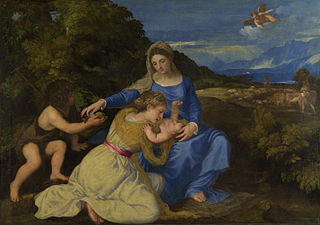
The Aldobrandini Madonna is an oil painting on canvas by Titian, dating to around 1530 and now in the National Gallery, London. There are studio copies in the Galleria Palatina in Florence and in the Kunsthistorisches Museum in Vienna.
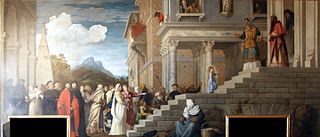
The Presentation of the Virgin at the Temple is a 1534–1538 painting by Titian. It depicts the three year-old Virgin Mary entering the Temple of Jerusalem. It was commissioned by the fraternity based in the Scuola Grande di Santa Maria della Carita, a building later incorporated into the Galleria dell'Accademia, where the work now hangs.
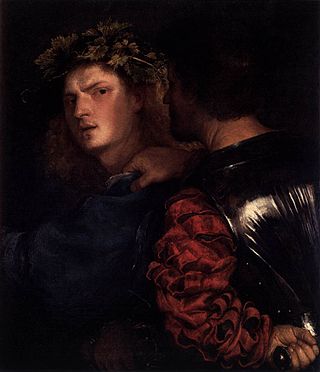
The Bravo is an oil painting usually attributed to Titian, dated to around 1516-17 and now in the Kunsthistorisches Museum in Vienna. The painting can be seen as one of a number of Venetian paintings of the 1510s showing two or three half-length figures with heads close together, often with their expressions and interactions enigmatic. Most of these are "Giorgionesque" genre or tronie subjects where the subjects are anonymous, though the group includes Titian's The Tribute Money, with Christ as the main figure, which in terms of style is similar to this painting, and his Lucretia and her Husband, also in Vienna, where at least the woman's identity is clear, if not that of the man.

Portrait of a Knight of Malta is an oil on canvas painting by Titian, from c. 1515. It depicts a knight belonging to the Order of Malta. It is now in the Uffizi, in Florence.

The Concert or The Interrupted Concert is a c. 1510–1511 oil on canvas painting by Titian, now in the Galleria Palatina, in Florence. A copy in the Galleria Borghese includes an additional fourth figure.

Madonna and Child with Saint Catherine of Alexandria is a c.1550 oil on panel painting by the studio of Titian, now in the Galleria degli Uffizi. It was restored around the end of the 18th century, when the present carved and gilded frame was probably added.

Portrait of Cardinal Alessandro Farnese is a c. 1545–46 oil on canvas three-quarter-length portrait of Alessandro Farnese the Younger (1520–1589) by Titian, now in the Museo nazionale di Capodimonte in Naples.

Portrait of Charles V or Portrait of a Man Wearing the Order of the Golden Fleece is an oil on canvas painting by Titian, from c. 1549. It is held now in the Museo di Capodimonte, in Naples.




















